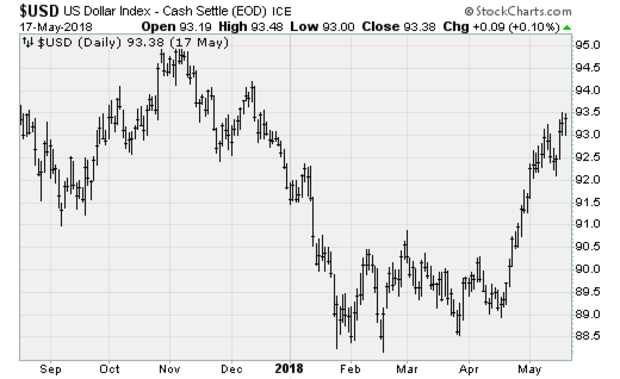What a stronger dollar means for investors
The bull run in U.S. equities has cooled of late, with stocks falling last week after two weeks of gains and investors seemingly indifferent to solid first-quarter results. Instead, the big market story has been the dollar's run: The PowerShares U.S. Dollar Index Bullish Fund (UUP) is up nearly 7 percent from lows seen in February, challenging highs last seen in November 2017.
While the move is dwarfed by crude-oil's rise of more than 24 percent, in the world of currency trading it's a big deal, with repercussions for investors. Here are three things to watch:
Gold punished
Moves in currency values likely have multiple causes, anything from inflation to interest rates to military action could play a role. So too does economic virility and trade balance. It's difficult to divine a cause without looking to other asset classes for clues.
All else equal, a rally in the dollar tends to be tied to weakness in alternative "safe havens," like precious metals or even bitcoin. Both have been hit in recent weeks, suggesting the dollar's rally is about easing geopolitical concerns, lately involving Syria and Iran, coupled with inflation worries.
Gold prices are down about six percent while bitcoin has fallen 18 percent from its early May high.
Emerging-market stocks hit
A strengthening dollar also increases the relatively attractiveness of U.S.-based assets when investors take currency gains and losses into account. Assuming stock prices in the U.S. and overseas remain the same, a foreign investor in U.S. assets would enjoy a lift in performance from the dollar's gain alone.
The dynamic has led the S&P 500 to outperform emerging-market stocks by 5.9 percent. Add in the 4 percent gain in the dollar, and a Chinese investor would see a nearly 10 percent increase in total return if they had moved into the S&P 500 -- thus the U.S. dollar -- in the middle of April.
U.S. small-cap stocks bolstered versus large caps
A stronger dollar tends to benefit smaller U.S. stocks versus large-cap equities because larger companies have more exposure to global markets. When you have a large share of revenue coming from overseas, a stronger dollar reduces its relative value.
Over the past two months, the Russell 2000 small-cap index has enjoyed a 4 percent performance advantage over the S&P 500 large-cap index and is trading at a record high.
Analysts at Perritt Capital Management note that historically, this is backed up by the data: When the dollar is strengthening, the Russell 2000 averages an annual total return of 13.2 percent compared to 10.3 percent for the S&P 500.





